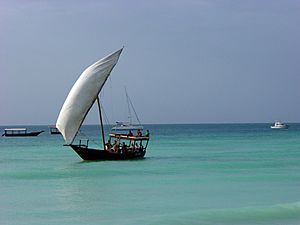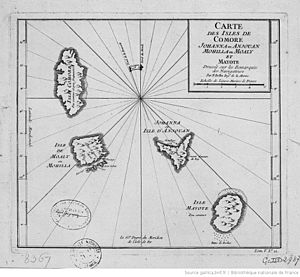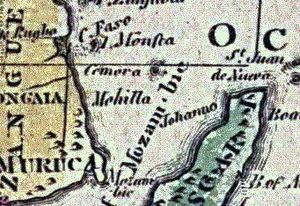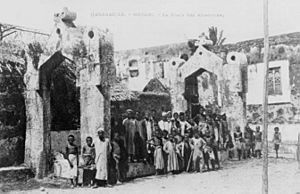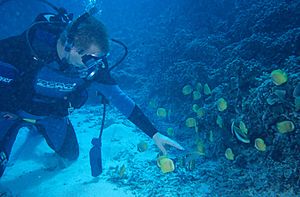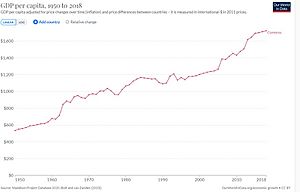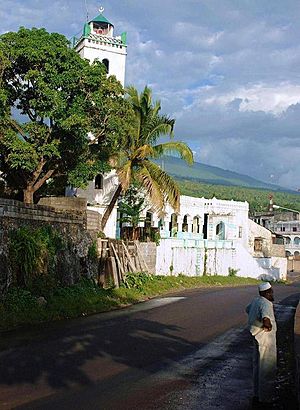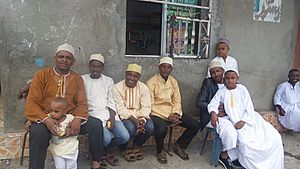Comoros facts for kids
Quick facts for kids
Union of the Comoros
|
|
|---|---|
|
Anthem: Udzima wa ya Masiwa (Comorian)
The Unity of the Great Islands |
|
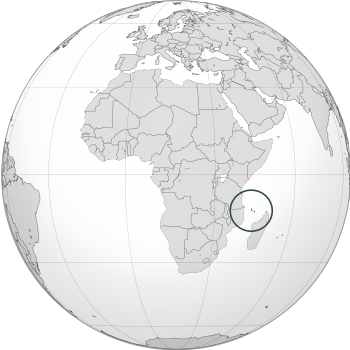
Location of the Comoros (circled)
|
|
| Capital and largest city
|
Moroni 11°41′S 43°16′E / 11.69°S 43.26°E |
| Official languages | |
| Ethnic groups
(2000)
|
|
| Demonym(s) | Comorian |
| Government | Federal presidential republic |
| Azali Assoumani | |
|
• President of the Assembly
|
Moustadroine Abdou |
| Legislature | Assembly of the Union |
| Formation | |
|
• Discovery by Portuguese Empire
|
1503 |
|
• French colony of Mayotte
|
25 April 1841 |
|
• Province of French Madagascar
|
31 March 1914 |
| 27 October 1946 | |
|
• Internal autonomy
|
22 December 1961 |
|
• Independence from France
|
6 July 1975 |
|
• Federal Islamic Republic
|
1 October 1978 |
|
• Union
|
23 December 2001 |
| Area | |
|
• Total
|
2,235 km2 (863 sq mi) (170th) |
|
• Water (%)
|
negligible |
| Population | |
|
• 2024 estimate
|
1,000,000 (160th) |
|
• Density
|
457/km2 (1,183.6/sq mi) (27th) |
| GDP (PPP) | 2023 estimate |
|
• Total
|
|
|
• Per capita
|
|
| GDP (nominal) | 2023 estimate |
|
• Total
|
|
|
• Per capita
|
|
| Gini (2014) | ▲ 45.3 medium |
| HDI (2022) | medium · 152nd |
| Currency | Comorian franc (KMF) |
| Time zone | UTC+3 (EAT) |
| Driving side | right |
| Calling code | +269 |
| ISO 3166 code | KM |
| Internet TLD | .km |
The Comoros, officially called the Union of the Comoros, is a country made of islands in Southeastern Africa. It is located in the Indian Ocean, at the northern end of the Mozambique Channel. Its capital and largest city is Moroni.
Most people in Comoros follow Sunni Islam, which is also the official state religion. Comoros became independent from France on July 6, 1975. It is a member of the Arab League and the only country in the Arab world located entirely in the Southern Hemisphere. It also belongs to the African Union, the Organisation internationale de la Francophonie, the Organisation of Islamic Co-operation, and the Indian Ocean Commission. The country has three official languages: Shikomori, French, and Arabic.
Comoros is one of Africa's smallest countries, covering about 1,659 km2 (641 sq mi). In 2019, its population was around 850,886. The country includes three main islands and many smaller ones. All are part of the volcanic Comoro Islands, except for Mayotte. Mayotte chose to remain part of France in a vote in 1974 and is still governed by France.
The Comoros islands were likely first settled by people from Southeast Asia, East Africa, and Arab traders. It became part of the French colonial empire in the 1800s before gaining independence in 1975. Since then, it has faced many political changes. The country also has high income inequality and ranks low on the Human Development Index.
Contents
What Does "Comoros" Mean?
The name "Comoros" comes from the Arabic word qamar, which means "moon".
A Quick Look at Comoros History
Early Settlers
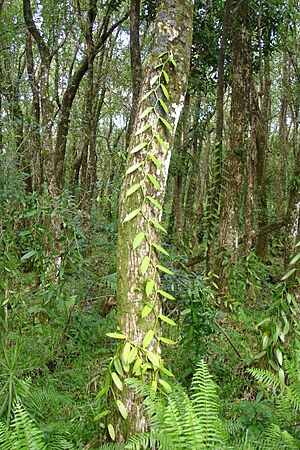
The first people to live on the Comoro Islands were likely settlers from Southeast Asia. They arrived by boat around the 8th century AD or even earlier. Later, people from East Africa, the Arabian Peninsula, and Madagascar also settled there. Some Bantu-speaking people were brought to the islands as slaves.
Trade with Madagascar and merchants from the Swahili coast and the Middle East grew from the 11th to the 15th centuries. More villages were built, and existing ones became larger. Settlers from the Arabian Peninsula also arrived during this time.
Medieval Times and Trade
Legend says that in 632 AD, islanders heard about Islam and sent someone to Mecca. He returned and built a mosque, leading to the islands' gradual conversion to Islam. By 933, Omani sailors called the Comoros the "Perfume Islands."
Early Islamic writings describe how Muslim traders visited the coast and islands. They searched for valuable goods like coral, ambergris, ivory, and gold. They also brought Islam to the people of the Zanj region, including the Comoros. The islands became an important trading hub along the Swahili coast.
Portuguese explorers arrived in the Indian Ocean in the late 1400s. The first Portuguese visit to the Comoros was in 1503. The islands supplied goods to Portuguese forts. Later, English ships and American whalers also used the islands as a stop.
By the end of the 16th century, local rulers and Omani sultans pushed back against European powers. The Comoros remained independent, though the largest island, Ngazidja, was divided into several small kingdoms.
European Contact and French Rule
In the late 1700s, warriors from Madagascar raided the Comoros for slaves. This caused much destruction. The islands were later repopulated with slaves from mainland Africa. By 1865, about 40% of the population were slaves.
France began its colonial rule by taking over Mayotte in 1841. They tried to turn Mayotte into a sugar plantation. Other islands like Ndzwani (Johanna) continued to trade with European and American ships. They exported coconuts, timber, and tortoiseshell. Settlers also started plantations for crops like vanilla, cloves, coffee, and ylang-ylang.
By 1908, all four islands were united under French rule. In 1914, they became a province of the French colony of Madagascar.
In 1973, France agreed to Comoros becoming independent in 1978. However, the people of Mayotte voted to stay with France. On July 6, 1975, the Comorian parliament declared independence for the three main islands. France recognized this new state later that year but kept control of Mayotte.
Independence and Political Changes
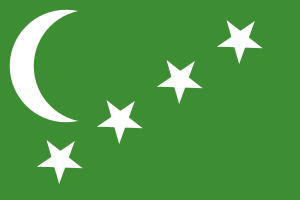
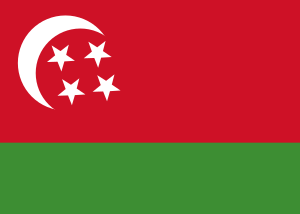
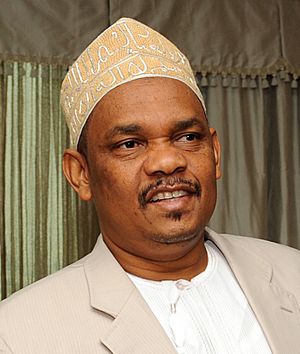
After independence in 1975, Comoros faced many political changes. There were several coups, where leaders were removed from power. In 1978, the country was renamed the Federal Islamic Republic of the Comoros.
The islands of Ndzwani and Mwali tried to declare their independence from Comoros in 1997. They wanted to return to French rule, but France refused. This led to conflicts. In 1999, Colonel Azali Assoumani took power in a peaceful coup.
To bring peace, the African Union helped create the Fomboni Accords in 2001. This agreement changed the country's name to the Union of the Comoros. It made the government more decentralized, giving more power to each island. The president of the Union would rotate between the islands every five years.
In 2021, Comoros signed a treaty to become a nuclear-weapon-free state. In 2023, Comoros was invited to the G7 summit and took over the presidency of the African Union.
Geography of the Comoros
The Comoros is made up of three main islands: Ngazidja, Mwali, and Ndzwani. There are also many smaller islands. The capital city, Moroni, is on Ngazidja. The islands are in the Indian Ocean, between Africa and Madagascar.
Comoros is one of the world's smallest countries. Its land area is 1,659 km2 (641 sq mi). The islands have steep mountains and low hills.
Here are the areas and populations of the main islands (from the 2017 Census):
| Name | Area km2 |
Population Census 2017 |
|---|---|---|
| Mwali | 211 | 51,567 |
| Ngazidja | 1,024 | 379,367 |
| Ndzwani | 424 | 327,382 |
| Totals | 1,659 | 758,316 |
Ngazidja is the largest island. It has two volcanoes: Karthala (active) and La Grille (dormant). Mwali is the smallest of the main islands. Ndzwani has a unique triangular shape with three mountain chains.
The islands were formed by volcanoes. Mount Karthala on Ngazidja is the highest point at 2,361 metres (7,746 feet). It is one of the most active volcanoes in the world. In 2005, an eruption caused 40,000 people to be evacuated.
Comoros also claims the Glorioso Islands, which are currently controlled by France.
Climate and Weather
The climate in Comoros is generally tropical and mild. There are two main seasons: a rainy season (November to April) and a cool, dry season (May to October). Temperatures average 29–30 °C (84–86 °F) in March and 19 °C (66 °F) in the cool season. Cyclones rarely hit the islands.
Nature and Wildlife
The Comoros has its own unique natural environment called the Comoros forests.
In 1952, a rare fish called the West Indian Ocean coelacanth was found off the Comoros coast. This species was thought to be extinct for 66 million years until it was first seen in 1938.
National Parks
Comoros has six national parks to protect its nature. These include Karthala National Park and Coelacanth on Grande Comore, Mount Ntringui National Park and Shisiwani National Park on Anjouan, and Mohéli National Park on Mohéli. Some parks protect mountains, while others protect marine areas and coral reefs.
How Comoros is Governed
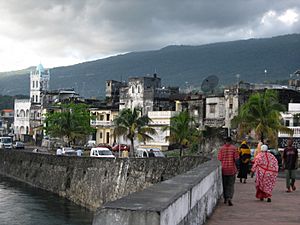
Comoros is a federal presidential republic. This means the President of the Comoros is both the head of state and the head of government. The country has a system with multiple political parties. The current constitution was approved in 2001.
Each island has a lot of independence, with its own constitution, president (now called governor), and parliament. The Union president is chosen from each island in rotation every five years. In 2006, there was a peaceful transfer of power, which was a big step for Comoros.
Laws and Justice
The legal system in Comoros combines Islamic law, French law (based on the Napoleonic Code), and traditional local laws. Most disagreements are settled by village elders, religious judges (kadis), or civilian courts. The courts are independent from the government and parliament. The Supreme Court handles constitutional questions and oversees presidential elections.
Foreign Relations
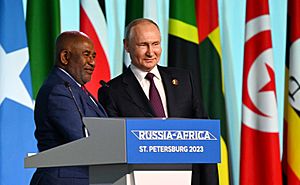
Comoros became a member of the United Nations in 1975. The country believes that Mayotte should be part of Comoros, even though Mayotte's citizens voted to remain French. The UN General Assembly has supported Comoros' claim, but Mayotte remains a French territory. In 2009, Mayotte voted again to become an overseas department and a region of France.
Comoros is a member of many international organizations, including the African Union, the Arab League, and the International Monetary Fund.
Military
The Comoros has a small army and police force. France helps protect Comoros' waters, trains its military, and provides air surveillance. France also keeps a small military presence on Mayotte.
Comoros Economy
Poverty is common in Comoros, but the number of people living in extreme poverty has decreased. Living conditions have generally improved. However, there is still a big gap between rich and poor, especially between rural and urban areas. Money sent home by Comorians living abroad helps the country's economy and improves living standards.
In 2019, more than half of the workers were in agriculture. About 29% worked in industry and 14% in services. The country's agriculture relies on exporting spices like vanilla, cinnamon, and cloves. Comoros is the world's largest producer of ylang-ylang, a plant used to make perfume.
The country faces challenges like a rapidly growing population and few natural resources. The government is working to improve education, health services, and tourism.
People and Culture
|
Largest cities or towns in Comoros
Source: |
||
|---|---|---|
| Rank | Name | Pop. |
| 1 | Moroni | 111,329 |
| 2 | Mutsamudu | 30,000 |
| 3 | Ouani | 22,501 |
| 4 | Mandza | 21,000 |
| 5 | Fomboni | 18,277 |
| 6 | Domoni | 16,276 |
| 7 | Adda-Douéni | 10,858 |
| 8 | Kourani | 10,000 |
| 9 | Bazimini | 8,952 |
| 10 | Mkazi | 8,438 |
Comoros has about 850,000 people, making it one of the least populated countries. However, it has a high population density. Almost half of the population is under 15 years old. Many Comorians also live in France.
Ethnic Groups
Most people in Comoros (97.1%) are ethnically Comorian. This group is a mix of Bantu, Malagasy, and Arab people. There are smaller groups like the Makua and people of Indian origin. A small number of people of Chinese origin also live in Grande Comore.
Languages Spoken
The main languages are the Comorian languages, known as Shikomori. These are related to Swahili. Each of the four islands has a slightly different version. Both Arabic and Latin scripts are used for writing.
Arabic and French are also official languages. Arabic is often learned as a second language for Quranic studies. French is used for government and most formal education.
Religion
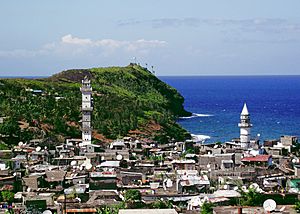
Sunni Islam is the main religion, followed by about 99% of the population. Comoros is the only Muslim-majority country in Southern Africa. A small number of people are Christian, including Catholics and Protestants.
Health and Education
There are 15 doctors for every 100,000 people. The average life expectancy is 67 for females and 62 for males.
Most children attend Quranic schools to learn about the Qur'an and the Arabic script. Many parents prefer this before their children go to the French-based school system. The public school system has faced challenges, but there are also private and community schools.
Before 2000, students had to go abroad for university. Now, there is a university in Comoros, which helps more educated people stay and work in the country. In 2004, about 57% of the population could read and write in the Latin alphabet, while over 90% could in the Arabic script.
Comorian Culture
Traditionally, women on Ndzwani wear red and white patterned clothes called shiromani. On Ngazidja and Mwali, they wear colorful shawls called leso. Many women also put a paste of ground sandalwood and coral called msindzano on their faces. Men often wear a long white shirt called a nkandu and a cap called a kofia.
Marriage Traditions
There are two types of marriages in Comoros: the "little marriage" (Mna daho) and the "customary marriage" (ada or harusi). The little marriage is simple and inexpensive. A man can have several Mna daho marriages.
The ada, or grand marriage, is a very important and expensive event. It involves dazzling gold jewelry, two weeks of celebrations, and a large dowry. Families and friends share the costs, but it can still be very costly. Many couples save their whole lives for their ada.
The ada marriage is a big step for a man in Ngazidja. It marks his transition from youth to elder. After this, he can speak in public and take part in village politics. He can also wear a special shawl and sit at the front of the mosque. A woman's status also changes as she becomes a "mother" and moves into her own house.
Family and Society
Comorian society has a system where family ties and inheritance are passed down through both the mother's and father's sides. However, the mother's side is more important for inheriting land and houses, especially on Ngazidja.
Music and Media
Twarab music, which came from Zanzibar in the early 1900s, is very popular. It is often played at ada marriages.
Comoros has two national newspapers: Al-Watwan (government-owned) and La Gazette des Comores (private). Both are published in Moroni. The government also runs national radio and television services. There are also local radio stations on the islands.
Images for kids
-
Flag of the Comoros (1963–1975)
-
Flag of the Comoros (1975–1978)
See also
 In Spanish: Comoras para niños
In Spanish: Comoras para niños
- Index of Comoros-related articles
- Outline of the Comoros




